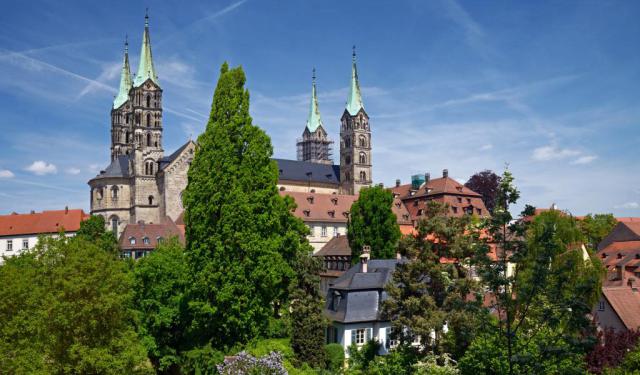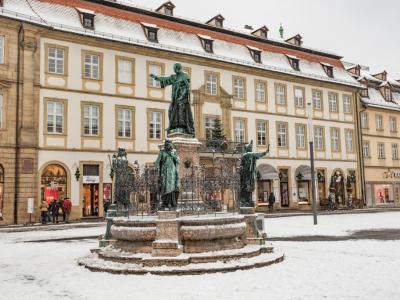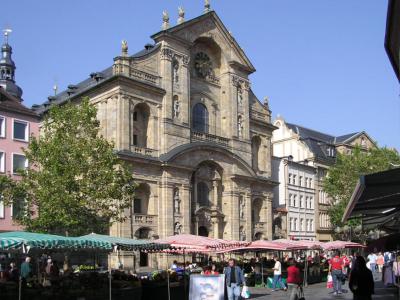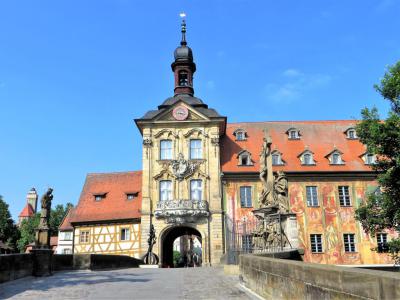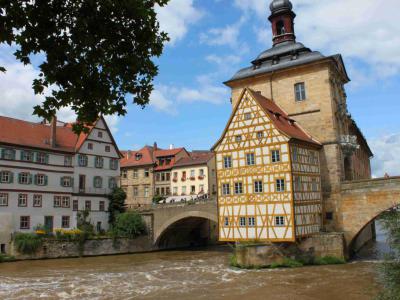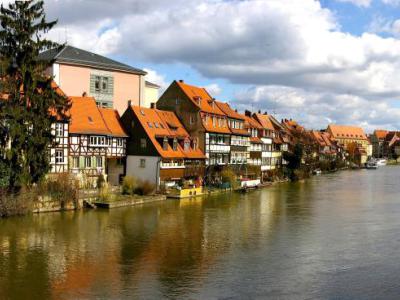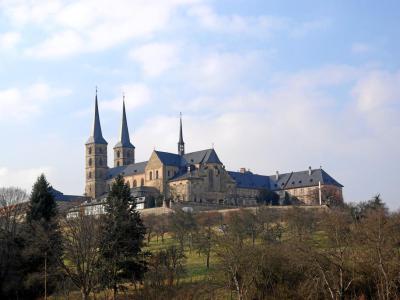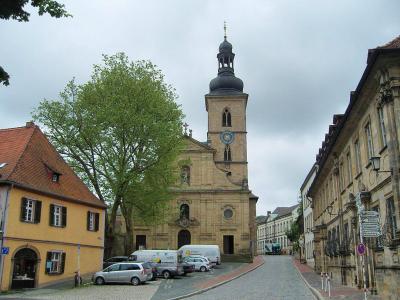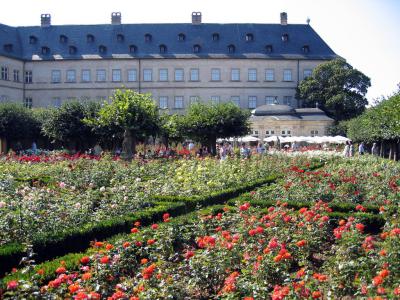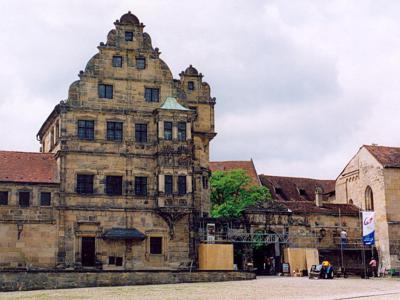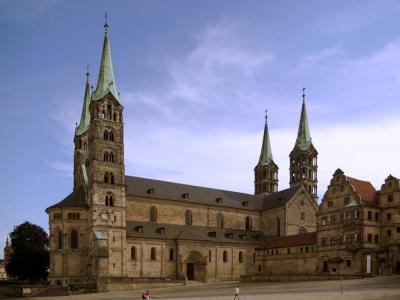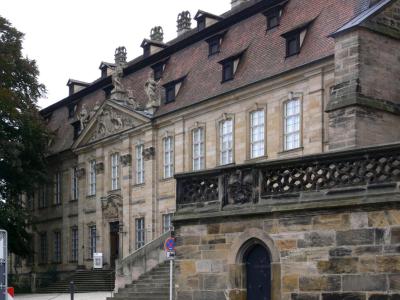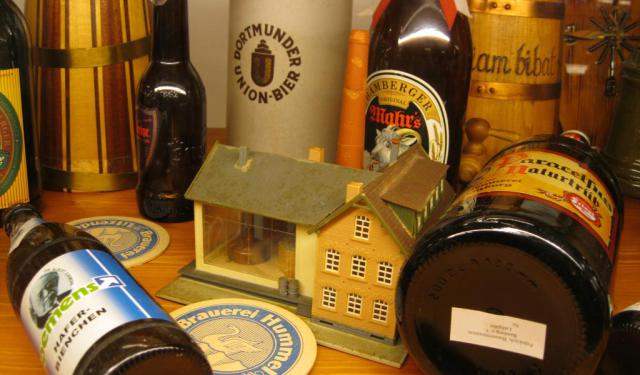Audio Guide: Bamber Introduction Walking Tour (Self Guided), Bamberg
“The happy Bamberg.” This cheerful phrase is often attributed to the renowned writer and thinker Johann Wolfgang von Goethe, who visited the city and expressed deep admiration for its charm. Whether or not he coined the exact words, the sentiment perfectly captures the sense of delight that Bamberg continues to inspire in its visitors.
Bamberg was founded in the 9th century and became a major center of the Holy Roman Empire. Its rise to prominence began in 1007 when King, later Emperor, Henry II established the Diocese of Bamberg. His goal was to create a northern “Rome,” strengthening imperial influence through a powerful religious and political hub. After his canonization, Bamberg became an important pilgrimage destination thanks to his tomb housed inside the city cathedral.
The city’s name derives from the early medieval term Babenberg, referring to a castle belonging to the influential Babenberg family. Over time, the name got simplified into “Bamberg.”
Throughout the Middle Ages, Bamberg emerged as a prosperous trading center. River connections linked it to the Rhine and Danube through the Main river, enabling commercial and cultural exchange. The city also built a reputation for beer production, a tradition that continues today, especially celebrated through its distinctive smoked beer called Rauchbier.
During the 17th century, Bamberg flourished architecturally under the prince-bishops of the Schönborn family, who introduced grand Baroque palaces and facades that still shape the cityscape. This period of wealth contrasted with the horrific Bamberg witch trials, among Europe’s most devastating. The same Prince-Bishopric that allowed for the development of Bamberg was responsible for the death of hundreds of people, often by means of torture.
Eventually, following the secularization of the Prince-Bishopric in 1802, Bamberg joined the Kingdom of Bavaria. Despite its complex political history, including the Nazi era, the city escaped heavy destruction during World War II, preserving its unique blend of Romanesque, Gothic, Renaissance, and Baroque architecture.
A stroll through Bamberg’s old town reveals a picturesque mix of medieval lanes, Baroque palaces, and riverside homes rising above narrow canals. Visitors encounter the towering cathedral and its famous Bamberg Horseman, the gleaming murals of the Old Town Hall set on a bridge, and charming fishermen’s houses in Little Venice. Breweries, lively cafés, and bustling squares animate the streets, while panoramic viewpoints spread across seven hills offer postcard-worthy views.
Bamberg has mostly kept all its elements that provide happiness, from the famous smoked beer to the architectural diversity. Apparently, the city casted its spell on a larger scale, as UNESCO awarded Bamberg's Old Town the title of a World Heritage Site in 1993. Surely Goethe could write a thing or two about this event. With a beer at his side, of course.
Bamberg was founded in the 9th century and became a major center of the Holy Roman Empire. Its rise to prominence began in 1007 when King, later Emperor, Henry II established the Diocese of Bamberg. His goal was to create a northern “Rome,” strengthening imperial influence through a powerful religious and political hub. After his canonization, Bamberg became an important pilgrimage destination thanks to his tomb housed inside the city cathedral.
The city’s name derives from the early medieval term Babenberg, referring to a castle belonging to the influential Babenberg family. Over time, the name got simplified into “Bamberg.”
Throughout the Middle Ages, Bamberg emerged as a prosperous trading center. River connections linked it to the Rhine and Danube through the Main river, enabling commercial and cultural exchange. The city also built a reputation for beer production, a tradition that continues today, especially celebrated through its distinctive smoked beer called Rauchbier.
During the 17th century, Bamberg flourished architecturally under the prince-bishops of the Schönborn family, who introduced grand Baroque palaces and facades that still shape the cityscape. This period of wealth contrasted with the horrific Bamberg witch trials, among Europe’s most devastating. The same Prince-Bishopric that allowed for the development of Bamberg was responsible for the death of hundreds of people, often by means of torture.
Eventually, following the secularization of the Prince-Bishopric in 1802, Bamberg joined the Kingdom of Bavaria. Despite its complex political history, including the Nazi era, the city escaped heavy destruction during World War II, preserving its unique blend of Romanesque, Gothic, Renaissance, and Baroque architecture.
A stroll through Bamberg’s old town reveals a picturesque mix of medieval lanes, Baroque palaces, and riverside homes rising above narrow canals. Visitors encounter the towering cathedral and its famous Bamberg Horseman, the gleaming murals of the Old Town Hall set on a bridge, and charming fishermen’s houses in Little Venice. Breweries, lively cafés, and bustling squares animate the streets, while panoramic viewpoints spread across seven hills offer postcard-worthy views.
Bamberg has mostly kept all its elements that provide happiness, from the famous smoked beer to the architectural diversity. Apparently, the city casted its spell on a larger scale, as UNESCO awarded Bamberg's Old Town the title of a World Heritage Site in 1993. Surely Goethe could write a thing or two about this event. With a beer at his side, of course.
How it works: Download the app "GPSmyCity: Walks in 1K+ Cities" from Apple App Store or Google Play Store to your mobile phone or tablet. The app turns your mobile device into a personal tour guide and its built-in GPS navigation functions guide you from one tour stop to next. The app works offline, so no data plan is needed when traveling abroad.
Bamber Introduction Walking Tour Map
Guide Name: Bamber Introduction Walking Tour
Guide Location: Germany » Bamberg (See other walking tours in Bamberg)
Guide Type: Self-guided Walking Tour (Sightseeing)
# of Attractions: 11
Tour Duration: 2 Hour(s)
Travel Distance: 2.8 Km or 1.7 Miles
Author: DanaOffice
Sight(s) Featured in This Guide:
Guide Location: Germany » Bamberg (See other walking tours in Bamberg)
Guide Type: Self-guided Walking Tour (Sightseeing)
# of Attractions: 11
Tour Duration: 2 Hour(s)
Travel Distance: 2.8 Km or 1.7 Miles
Author: DanaOffice
Sight(s) Featured in This Guide:
- Maximiliansplatz (Maximilian Square)
- Martinskirche (Saint Martin's Church)
- Altes Rathaus (Old Town Hall)
- Upper and Lower Bridges
- Klein-Venedig (Little Venice)
- Kloster Michaelsberg (Saint Michael's Abbey)
- Jakobskirche (Church of Saint James)
- New Residence and Rose Garden
- Old Court Hall and Historical Museum
- Bamberg Cathedral and Square
- Diözesanmuseum (Diocesan Museum)
1) Maximiliansplatz (Maximilian Square)
Maximilian Square's origins date back to the early 19th century, during a period of urban transformation that followed Bamberg’s integration into the Kingdom of Bavaria in 1802. The square was laid out as part of modernization efforts initiated under King Maximilian I Joseph of Bavaria, for whom it is named. Over time, it replaced an older, more cramped market area and evolved into the city’s main civic square.
Architecturally, the surroundings of Maximilian Square reflect Bamberg’s transition from its medieval heritage into a modern administrative era. The most prominent building overlooking the square is the New Town Hall, completed in 1805. Its clean, neoclassical façade marked a clear shift away from the ornate Baroque style that characterized the previous century. Nearby, elegant townhouses, shops, cafés, and cultural venues contribute to the square’s lively, urban atmosphere.
One of the notable features of Maximilian Square is the magnificent Maximilians Fountain, created in 1888. The centerpiece of the fountain is a bronze statue of the very founder of the square – the same King Maximilian I. Around him, the fountain's bowl is surrounded by an intricate cast-iron fence adorned with four statues of significant and legendary figures.
Today, Maximilian Square serves as a vibrant commercial and social hub. Weekly fresh-produce markets bring local flavors into the heart of the city, while seasonal events — including Christmas markets and festival activities — fill the square with color and community spirit. At any time of year, visitors will find bustling terraces, street performances, and easy access to Bamberg’s main pedestrian streets that branch out from the square.
Architecturally, the surroundings of Maximilian Square reflect Bamberg’s transition from its medieval heritage into a modern administrative era. The most prominent building overlooking the square is the New Town Hall, completed in 1805. Its clean, neoclassical façade marked a clear shift away from the ornate Baroque style that characterized the previous century. Nearby, elegant townhouses, shops, cafés, and cultural venues contribute to the square’s lively, urban atmosphere.
One of the notable features of Maximilian Square is the magnificent Maximilians Fountain, created in 1888. The centerpiece of the fountain is a bronze statue of the very founder of the square – the same King Maximilian I. Around him, the fountain's bowl is surrounded by an intricate cast-iron fence adorned with four statues of significant and legendary figures.
Today, Maximilian Square serves as a vibrant commercial and social hub. Weekly fresh-produce markets bring local flavors into the heart of the city, while seasonal events — including Christmas markets and festival activities — fill the square with color and community spirit. At any time of year, visitors will find bustling terraces, street performances, and easy access to Bamberg’s main pedestrian streets that branch out from the square.
2) Martinskirche (Saint Martin's Church)
Saint Martin’s Church was constructed between 1686 and 1693 by the Jesuits, who sought to establish a strong presence in Bamberg during the Catholic Revival, as an alternative to the Protestant reformations at the time. The main inspiration for the church's design was Rome's renowned church, Jesus Christ. For over a century it also bore the name of Jesus Christ.
Architecturally, Saint Martin’s Church stands out from the predominantly medieval urban landscape. Its elegant Baroque façade features sculpted figures, spirals, and a distinctive curved gable that adds grandeur to the heart of modern Bamberg. Inside, the church reveals a richly decorated single-nave interior with ornate plaster, expressive altarpieces, and carefully balanced spatial harmony.
Among its highlights is the main altar, adorned with vibrant artwork illustrating the life and martyrdom of Saint Martin of Tours, the church’s patron saint known for his charitable spirit. Visitors may also notice commemorative inscriptions and memorials that trace the building’s transformation after the Jesuit order was dissolved in the 18th century. In 1803, with Bamberg’s ecclesiastical reorganization, Saint Martin became the city’s official parish church, a role it continues to hold.
Situated directly along Bamberg’s main shopping street, Saint Martin’s remains an active spiritual center while offering a peaceful refuge from the surrounding bustle.
Architecturally, Saint Martin’s Church stands out from the predominantly medieval urban landscape. Its elegant Baroque façade features sculpted figures, spirals, and a distinctive curved gable that adds grandeur to the heart of modern Bamberg. Inside, the church reveals a richly decorated single-nave interior with ornate plaster, expressive altarpieces, and carefully balanced spatial harmony.
Among its highlights is the main altar, adorned with vibrant artwork illustrating the life and martyrdom of Saint Martin of Tours, the church’s patron saint known for his charitable spirit. Visitors may also notice commemorative inscriptions and memorials that trace the building’s transformation after the Jesuit order was dissolved in the 18th century. In 1803, with Bamberg’s ecclesiastical reorganization, Saint Martin became the city’s official parish church, a role it continues to hold.
Situated directly along Bamberg’s main shopping street, Saint Martin’s remains an active spiritual center while offering a peaceful refuge from the surrounding bustle.
3) Altes Rathaus (Old Town Hall) (must see)
The Old Town Hall is one of Bamberg’s most unforgettable landmarks — a structure so boldly placed that it appears to float above the Regnitz River. According to local legend, the Bishop of Bamberg refused to grant the townspeople land for a new civic hall, prompting them to take matters into their own hands. They built it on an artificial island right at the center of the river, symbolically and physically positioning civic power between the ecclesiastical and merchant quarters of the city.
The first version of the building dates back to the 14th century, but its current appearance is largely the result of 18th-century renovations in a richly decorative Baroque and Rococo style. Its exterior is adorned with vivid paintings that create a theatrical illusion — painted figures appear to step out from the walls, blurring the line between art and architecture. On the river-facing side, a small half-timbered projection clings to the façade, often featured in photographs as one of the city’s most charming details.
Inside, the highlight is the Rococo Hall, once used for council meetings and festive receptions. Its ornate plaster work and painted ceiling pair perfectly with the Ludwig collection. The latter consists of 300 18th century pieces such as animal-shaped tureens, figurines, and dinner services crafted from porcelain. If your trip happens to be during December, a holiday season special unravels – 400 special porcelain figures depicting a nativity scene.
Outside once more, the Old Town Hall offers an excellent vantage point. From its arcades, visitors can admire Bamberg’s famous “Little Venice,” with its line of fishermen’s houses along the water. Step onto the bridge and see for yourself how this remarkably original town hall continues to connect the city — both literally and figuratively.
The first version of the building dates back to the 14th century, but its current appearance is largely the result of 18th-century renovations in a richly decorative Baroque and Rococo style. Its exterior is adorned with vivid paintings that create a theatrical illusion — painted figures appear to step out from the walls, blurring the line between art and architecture. On the river-facing side, a small half-timbered projection clings to the façade, often featured in photographs as one of the city’s most charming details.
Inside, the highlight is the Rococo Hall, once used for council meetings and festive receptions. Its ornate plaster work and painted ceiling pair perfectly with the Ludwig collection. The latter consists of 300 18th century pieces such as animal-shaped tureens, figurines, and dinner services crafted from porcelain. If your trip happens to be during December, a holiday season special unravels – 400 special porcelain figures depicting a nativity scene.
Outside once more, the Old Town Hall offers an excellent vantage point. From its arcades, visitors can admire Bamberg’s famous “Little Venice,” with its line of fishermen’s houses along the water. Step onto the bridge and see for yourself how this remarkably original town hall continues to connect the city — both literally and figuratively.
4) Upper and Lower Bridges
The Upper Bridge and Lower Bridge form one of the most iconic and photogenic areas of Bamberg, crossing the Regnitz River right in the heart of the old town. Their strategic position connects the cathedral district on the hills with the merchants’ quarter across the water, making them vital arteries of the medieval city. The Old Town Hall, famously built on an artificial island between the bridges, creates an unforgettable scene.
The Upper Bridge is the older of the two, dating back to the 12th century. Broadly aligned with Bamberg’s main pedestrian routes, it became a central link between the clerical authorities on the hills and the bustling market life below. From here, visitors are treated to classic postcard views of the Old Town Hall’s illusionistic frescoes and the flowing river beneath its arches.
Just a few steps downstream, the Lower Bridge offers a different yet equally memorable experience. A prominent feature at its entrance is the statue of Saint Cunigunde, the revered wife of Holy Roamn Emperor Henry II and one of Bamberg’s most significant patron figures. When her husband fell seriously ill and eventually passed away, she briefly took the responsibility of managing the German Monarchy. Her fair rule attracted gratitude from people, so much so that a local legend claims that she protected Bamberg during World War II by enveloping the city in a cloak of mists.
From the Lower Bridge's vantage point, the scene opens toward Little Venice, a row of colorful former fishermen’s houses lined up along the water — one of Bamberg’s most beloved panoramas.
Like close companions, the two bridges enhance each other’s presence — but each stands strong on its own. Take the time to cross both, and you will not be disappointed.
The Upper Bridge is the older of the two, dating back to the 12th century. Broadly aligned with Bamberg’s main pedestrian routes, it became a central link between the clerical authorities on the hills and the bustling market life below. From here, visitors are treated to classic postcard views of the Old Town Hall’s illusionistic frescoes and the flowing river beneath its arches.
Just a few steps downstream, the Lower Bridge offers a different yet equally memorable experience. A prominent feature at its entrance is the statue of Saint Cunigunde, the revered wife of Holy Roamn Emperor Henry II and one of Bamberg’s most significant patron figures. When her husband fell seriously ill and eventually passed away, she briefly took the responsibility of managing the German Monarchy. Her fair rule attracted gratitude from people, so much so that a local legend claims that she protected Bamberg during World War II by enveloping the city in a cloak of mists.
From the Lower Bridge's vantage point, the scene opens toward Little Venice, a row of colorful former fishermen’s houses lined up along the water — one of Bamberg’s most beloved panoramas.
Like close companions, the two bridges enhance each other’s presence — but each stands strong on its own. Take the time to cross both, and you will not be disappointed.
5) Klein-Venedig (Little Venice)
Little Venice is one of the most charming and widely photographed areas of Bamberg. Stretching along the eastern bank of the Regnitz River, this picturesque row of half-timbered houses once formed the medieval fishermen’s quarter — a lively but humble neighborhood where boatmen lived and worked right by the water. The tightly packed homes, dating largely from the 15th to 17th centuries, feature gabled roofs, wooden balconies, and small gardens that dip directly into the river, creating a postcard-worthy scenes.
Although the nickname “Little Venice” only became popular in the 19th century, the riverside lifestyle it refers to has much older roots. Fishermen here relied on the Regnitz river for both livelihood and transportation, and many houses still include historic boathouses or winches used to hoist small vessels from the water. Life in the quarter was modest, but its residents played an important role in the city’s economy, supplying fresh fish to Bamberg’s bustling medieval markets.
Today, Little Venice has transformed from a working district into a beloved attraction, admired for its atmospheric beauty rather than its industry. The best views can be enjoyed from the Lower Bridge, where the colorful façades ripple in the water below, or from the river itself aboard a gentle sightseeing cruise. During the annual Sandkerwa festival — Bamberg’s spirited folk celebration — illuminated boats float past the riverfront houses in a tradition that revives the historic heart of the neighborhood. The colorful houses can be described in many ways, and it’s up to you to decide what the narrative will be — whatever floats your boat.
Although the nickname “Little Venice” only became popular in the 19th century, the riverside lifestyle it refers to has much older roots. Fishermen here relied on the Regnitz river for both livelihood and transportation, and many houses still include historic boathouses or winches used to hoist small vessels from the water. Life in the quarter was modest, but its residents played an important role in the city’s economy, supplying fresh fish to Bamberg’s bustling medieval markets.
Today, Little Venice has transformed from a working district into a beloved attraction, admired for its atmospheric beauty rather than its industry. The best views can be enjoyed from the Lower Bridge, where the colorful façades ripple in the water below, or from the river itself aboard a gentle sightseeing cruise. During the annual Sandkerwa festival — Bamberg’s spirited folk celebration — illuminated boats float past the riverfront houses in a tradition that revives the historic heart of the neighborhood. The colorful houses can be described in many ways, and it’s up to you to decide what the narrative will be — whatever floats your boat.
6) Kloster Michaelsberg (Saint Michael's Abbey) (must see)
Saint Michael’s Abbey stands proudly atop Michaelsberg Hill, overlooking Bamberg with one of the city’s most commanding viewpoints. Founded in 1015 by Empress Cunigunde and Emperor Henry II, the Benedictine monastery soon became a major religious and intellectual center within the Holy Roman Empire. For centuries, its monks contributed to the region’s education, manuscript production, and spiritual life, strengthening Bamberg’s reputation as a place of cultural significance.
Architecturally, the abbey reflects an intriguing blend of Romanesque foundations and later Baroque additions. Its church, with a long, majestic nave, invites visitors into an atmosphere of solemn beauty. One of its most famous interior features is the “Garden of Heaven” ceiling painting, where hundreds of plants and herbs appear to bloom across the vaulting. Each species is depicted with scientific precision. The abbey complex also includes a grand terraced garden and historic buildings that once housed workshops, a brewery, and living quarters.
Despite secularization in the early 19th century, which brought monastic life to an end, Saint Michael’s Abbey has remained an essential part of Bamberg’s identity. In recent years, major restoration efforts have been underway to preserve the structure, and while some interior areas may be temporarily closed, the surrounding grounds remain accessible. From the terraces and nearby viewpoints, visitors can enjoy exceptional panoramas of the old town — red rooftops, cathedral towers, and the winding Regnitz far below.
Architecturally, the abbey reflects an intriguing blend of Romanesque foundations and later Baroque additions. Its church, with a long, majestic nave, invites visitors into an atmosphere of solemn beauty. One of its most famous interior features is the “Garden of Heaven” ceiling painting, where hundreds of plants and herbs appear to bloom across the vaulting. Each species is depicted with scientific precision. The abbey complex also includes a grand terraced garden and historic buildings that once housed workshops, a brewery, and living quarters.
Despite secularization in the early 19th century, which brought monastic life to an end, Saint Michael’s Abbey has remained an essential part of Bamberg’s identity. In recent years, major restoration efforts have been underway to preserve the structure, and while some interior areas may be temporarily closed, the surrounding grounds remain accessible. From the terraces and nearby viewpoints, visitors can enjoy exceptional panoramas of the old town — red rooftops, cathedral towers, and the winding Regnitz far below.
7) Jakobskirche (Church of Saint James)
The Church of Saint James stands along the historic route up to Bamberg Cathedral, serving as a welcoming point for pilgrims for nearly a thousand years. Founded in the early 12th century and consecrated in 1109, it was established as a church for pilgrims traveling toward Santiago de Compostela, honoring Saint James the Greater — the patron saint of travelers. Its location near the Cathedral Hill made it a natural spiritual stop for those seeking blessings and rest before continuing their journey.
The building’s architecture reflects the transition from late Romanesque to early Gothic forms. Its sturdy outer walls and round-arched windows recall medieval simplicity, while later additions, including pointed vaults and fine sculptural elements, reveal how the church evolved with changing artistic styles. The tower, with its distinctive shape, contributes to the layered skyline of Bamberg’s upper town.
Inside, the atmosphere remains contemplative and intimate compared to the grandeur of Bamberg Cathedral. Visitors can find notable artworks, including medieval stone reliefs, Baroque altars, and a finely carved depiction of Saint James.
Nowadays, many still pause here to light a candle, appreciate the quiet architectural beauty, or simply catch their breath before climbing further uphill. The avenue of acacia trees that frames the church creates exactly what is needed — a serene and reflective space.
The building’s architecture reflects the transition from late Romanesque to early Gothic forms. Its sturdy outer walls and round-arched windows recall medieval simplicity, while later additions, including pointed vaults and fine sculptural elements, reveal how the church evolved with changing artistic styles. The tower, with its distinctive shape, contributes to the layered skyline of Bamberg’s upper town.
Inside, the atmosphere remains contemplative and intimate compared to the grandeur of Bamberg Cathedral. Visitors can find notable artworks, including medieval stone reliefs, Baroque altars, and a finely carved depiction of Saint James.
Nowadays, many still pause here to light a candle, appreciate the quiet architectural beauty, or simply catch their breath before climbing further uphill. The avenue of acacia trees that frames the church creates exactly what is needed — a serene and reflective space.
8) New Residence and Rose Garden (must see)
The New Residence stands prominently on Cathedral Hill, reflecting the wealth and authority of Bamberg’s prince-bishops during the Baroque era. Construction began in the early 17th century under Prince-Bishop von Gebsattel, with later expansions executed by renowned architects of the Schönborn family’s rule in the 18th century. Replacing earlier episcopal quarters, the palace represented a shift toward more modern and sumptuous living standards for the city’s ecclesiastical rulers.
The façade, with its orderly rows of sandstone windows, marks the transition from Renaissance influences into mature Baroque elegance. Inside, over forty lavishly decorated rooms once hosted aristocratic gatherings and diplomatic receptions. Among the highlights are the Imperial Hall, adorned with opulent ceiling frescoes celebrating the Holy Roman Empire, and the Electors’ Hall, featuring grand portraits of prince-bishops and imperial electors — symbols of the power centered in Bamberg during its golden age.
These days, the building houses both a state gallery and a library. The gallery includes over 500 works of furniture, painting, sculpture, and textile art, while the library preserves a rich collection of books and manuscripts. Together, they span more than four centuries of cultural heritage, underscoring Bamberg’s intellectual legacy.
Behind the palace lies one of the city’s most beloved places: the Rose Garden. Designed in the 1730s, the garden is arranged in formal Baroque symmetry with patterned flowerbeds and elegant sandstone sculptures. In summer, more than 4,500 roses bloom here in vibrant colors, filling the air with a soft fragrance.
From the garden terraces, visitors can enjoy one of Bamberg’s finest panoramas — a sweeping view of the old town’s red roofs, church towers, and the distant hills beyond. Café seating and open pathways invite travelers to pause, take photographs, or simply savor the peaceful atmosphere above the lively streets below. The New Residence allows for multiple ways to get lost in its charm, whether it is the sea of roses or the elegance of the building itself.
The façade, with its orderly rows of sandstone windows, marks the transition from Renaissance influences into mature Baroque elegance. Inside, over forty lavishly decorated rooms once hosted aristocratic gatherings and diplomatic receptions. Among the highlights are the Imperial Hall, adorned with opulent ceiling frescoes celebrating the Holy Roman Empire, and the Electors’ Hall, featuring grand portraits of prince-bishops and imperial electors — symbols of the power centered in Bamberg during its golden age.
These days, the building houses both a state gallery and a library. The gallery includes over 500 works of furniture, painting, sculpture, and textile art, while the library preserves a rich collection of books and manuscripts. Together, they span more than four centuries of cultural heritage, underscoring Bamberg’s intellectual legacy.
Behind the palace lies one of the city’s most beloved places: the Rose Garden. Designed in the 1730s, the garden is arranged in formal Baroque symmetry with patterned flowerbeds and elegant sandstone sculptures. In summer, more than 4,500 roses bloom here in vibrant colors, filling the air with a soft fragrance.
From the garden terraces, visitors can enjoy one of Bamberg’s finest panoramas — a sweeping view of the old town’s red roofs, church towers, and the distant hills beyond. Café seating and open pathways invite travelers to pause, take photographs, or simply savor the peaceful atmosphere above the lively streets below. The New Residence allows for multiple ways to get lost in its charm, whether it is the sea of roses or the elegance of the building itself.
9) Old Court Hall and Historical Museum
The Old Court, located directly beside Bamberg Cathedral, forms one of the most atmospheric historic spaces in the city. This complex once served as the residence and administrative headquarters of the Bamberg bishopric before the construction of the New Residence. Its origins stretch back to the 11th century, when Emperor Henry II established a royal palace here, anchoring Bamberg’s role as an imperial seat.
Over the centuries, the buildings evolved into a fortified ensemble of half-timbered galleries, sandstone façades, workshops, and administrative rooms, arranged around a wide inner courtyard. The grand Renaissance gateway, adorned with reliefs of saints and imperial figures, still welcomes visitors with open arms.
Inside the Old Court, the Historical Museum Bamberg invites guests to explore the city’s long and layered story. The museum’s collection covers everything from medieval art and religious sculpture to coins, textiles, and artifacts reflecting Bamberg’s role in the Holy Roman Empire. Hence, the most notable exhibition focuses on the Imperial Regalia replicas, showcasing the city's imperial past. Other displays examine Bamberg’s evolution through the Baroque period, everyday life in past centuries, and the city’s rich tradition of crafts and guilds.
The courtyard itself is just as compelling as the museum. Its timber-framed balconies and stone arcades create a cinematic backdrop — so distinctive that filmmakers have used it for medieval settings, including a 2011 adaptation of The Three Musketeers starring Orlando Bloom, Milla Jovovich, and Christoph Waltz. During festivals and summer events, the space transforms into an open-air stage filled with music, theatre, and community celebrations.
Over the centuries, the buildings evolved into a fortified ensemble of half-timbered galleries, sandstone façades, workshops, and administrative rooms, arranged around a wide inner courtyard. The grand Renaissance gateway, adorned with reliefs of saints and imperial figures, still welcomes visitors with open arms.
Inside the Old Court, the Historical Museum Bamberg invites guests to explore the city’s long and layered story. The museum’s collection covers everything from medieval art and religious sculpture to coins, textiles, and artifacts reflecting Bamberg’s role in the Holy Roman Empire. Hence, the most notable exhibition focuses on the Imperial Regalia replicas, showcasing the city's imperial past. Other displays examine Bamberg’s evolution through the Baroque period, everyday life in past centuries, and the city’s rich tradition of crafts and guilds.
The courtyard itself is just as compelling as the museum. Its timber-framed balconies and stone arcades create a cinematic backdrop — so distinctive that filmmakers have used it for medieval settings, including a 2011 adaptation of The Three Musketeers starring Orlando Bloom, Milla Jovovich, and Christoph Waltz. During festivals and summer events, the space transforms into an open-air stage filled with music, theatre, and community celebrations.
10) Bamberg Cathedral and Square (must see)
Bamberg Cathedral commands the heart of the city from Cathedral Hill, where its four soaring towers define the skyline. Founded by Emperor Henry II and consecrated in 1012, the cathedral symbolizes Bamberg’s emergence as an important spiritual and political center of the Holy Roman Empire. After a devastating fire in the 13th century, it was rebuilt in a late Romanesque–early Gothic style, giving the structure its distinctive mix of round arches and pointed vaults. Throughout the centuries, it remained the seat of Bamberg’s powerful prince-bishops and the focal point of religious life in the region.
Inside the cathedral lie two remarkable tombs of great historical significance. The first belongs to Emperor Henry II and Empress Cunigunde, Bamberg’s imperial founders, immortalized in an exquisite marble sarcophagus. The second is the tomb of Pope Clement II, the only pope buried north of the Alps. The interior also houses the famous Bamberg Horseman, a mysterious 13th-century equestrian statue whose identity — king, knight, or saint — remains a subject of debate.
Beyond its interior treasures, the cathedral opens onto its namesake square, one of the most atmospheric places in Bamberg. Ringed by historic buildings such as the Old Court and the New Residence, the square once served as the ceremonial stage for imperial visits and religious processions. Today, its spacious cobblestones offer visitors a striking vantage point to admire the cathedral’s sculpted portals, especially the ornate Prince’s Portal with its biblical figures and expressive carvings.
The cathedral does not try to hide, thanks to its soaring 81 meter high towers. When you see them, do not hide your awe. Get closer, step inside and dream away at all the possibilities the cathedral offers.
Inside the cathedral lie two remarkable tombs of great historical significance. The first belongs to Emperor Henry II and Empress Cunigunde, Bamberg’s imperial founders, immortalized in an exquisite marble sarcophagus. The second is the tomb of Pope Clement II, the only pope buried north of the Alps. The interior also houses the famous Bamberg Horseman, a mysterious 13th-century equestrian statue whose identity — king, knight, or saint — remains a subject of debate.
Beyond its interior treasures, the cathedral opens onto its namesake square, one of the most atmospheric places in Bamberg. Ringed by historic buildings such as the Old Court and the New Residence, the square once served as the ceremonial stage for imperial visits and religious processions. Today, its spacious cobblestones offer visitors a striking vantage point to admire the cathedral’s sculpted portals, especially the ornate Prince’s Portal with its biblical figures and expressive carvings.
The cathedral does not try to hide, thanks to its soaring 81 meter high towers. When you see them, do not hide your awe. Get closer, step inside and dream away at all the possibilities the cathedral offers.
11) Diözesanmuseum (Diocesan Museum)
The Diocesan Museum is located directly beside Bamberg Cathedral, occupying part of the former cathedral chapter buildings. Established in 1966, the museum was created to safeguard and present the rich collection of treasures associated with Bamberg’s ecclesiastical history — spanning over a millennium. Its exhibitions offer visitors a compelling look at the city’s spiritual legacy, closely tied to its role as a major religious center of the Holy Roman Empire.
Among the museum’s most significant highlights is the Imperial Regalia of Bamberg, including precious embroidered robes once worn by Emperor Henry II, Empress Cunigunde, and the medieval clergy. These garments, featuring intricate gold thread and elaborate motifs, reflect exceptional craftsmanship. As Pope Clement II is also buried in the Cathedral nearby, his papal regalia is part of the display. It is fitting, after all.
The museum also houses a rare collection of Romanesque sculptures, liturgical vessels, manuscripts, reliquaries, and carved ivories that illustrate the evolution of Christian art from the Middle Ages through the Baroque period. Particularly notable are the Nativity tapestry cycle from the 11th century and ornate chalices that once played central roles in high church ceremonies.
Last but not least, the ground floor of the museum showcases architectural fragments from earlier cathedral structures, including parts of the Baroque building that was lost to fire centuries ago. In many ways, the museum ensures that no chapter of Bamberg’s heritage is forgotten.
Walking through the museum’s vaulted rooms, visitors gain insight not only into the artistry of the Catholic tradition but also into the political and cultural influence once wielded by Bamberg’s prince-bishops. Exhibits are arranged with clarity, allowing guests to approach delicate treasures up close while appreciating the context of their use in the cathedral just steps away.
Among the museum’s most significant highlights is the Imperial Regalia of Bamberg, including precious embroidered robes once worn by Emperor Henry II, Empress Cunigunde, and the medieval clergy. These garments, featuring intricate gold thread and elaborate motifs, reflect exceptional craftsmanship. As Pope Clement II is also buried in the Cathedral nearby, his papal regalia is part of the display. It is fitting, after all.
The museum also houses a rare collection of Romanesque sculptures, liturgical vessels, manuscripts, reliquaries, and carved ivories that illustrate the evolution of Christian art from the Middle Ages through the Baroque period. Particularly notable are the Nativity tapestry cycle from the 11th century and ornate chalices that once played central roles in high church ceremonies.
Last but not least, the ground floor of the museum showcases architectural fragments from earlier cathedral structures, including parts of the Baroque building that was lost to fire centuries ago. In many ways, the museum ensures that no chapter of Bamberg’s heritage is forgotten.
Walking through the museum’s vaulted rooms, visitors gain insight not only into the artistry of the Catholic tradition but also into the political and cultural influence once wielded by Bamberg’s prince-bishops. Exhibits are arranged with clarity, allowing guests to approach delicate treasures up close while appreciating the context of their use in the cathedral just steps away.
Walking Tours in Bamberg, Germany
Create Your Own Walk in Bamberg
Creating your own self-guided walk in Bamberg is easy and fun. Choose the city attractions that you want to see and a walk route map will be created just for you. You can even set your hotel as the start point of the walk.
Best Brewpubs In Bamberg Walk
"Brewer's Paradise". Speaking of Bamberg, the town that is regarded as one of the beer capitals of Germany, this expression encapsulates the image of a true haven for beer lovers and brewers alike. Bamberg's "liquid history" goes back over 900 years. The first documented mention of brewing in Bamberg dates to 1122 and the city has been closely associated with beer... view more
Tour Duration: 1 Hour(s)
Travel Distance: 2.7 Km or 1.7 Miles
Tour Duration: 1 Hour(s)
Travel Distance: 2.7 Km or 1.7 Miles
The Most Popular Cities
/ view all
